Southwest Michigan field crops update – May 11, 2023
Ideal weather conditions helped soils dry out and allowed for a flush of planting and other field operations this past week.

Weather
Temperatures this past week started cool but have been warmer than normal the past few days resulting in a near-average week. Soil temperatures have held above 50 degrees Fahrenheit since last weekend and should not be an issue moving forward. With the increase in temperatures, heat unit accumulation has increased as expected, and crops planted near the middle of April should be emerging in the coming week. Michigan State University Extension climatologist Jeff Andresen says that NOAA is predicting an upper-air trough over Canada and the Great Lakes region will bring cooler temperatures to Michigan next week. Even so, with mostly clear skies next week, the forecasted reference evapotranspiration rate (FRET) is roughly 1.3 inches in the southwest for the week ending May 17. Both the 6-10 and 8-14 day outlooks call for cooler than normal weather through the third week of May.

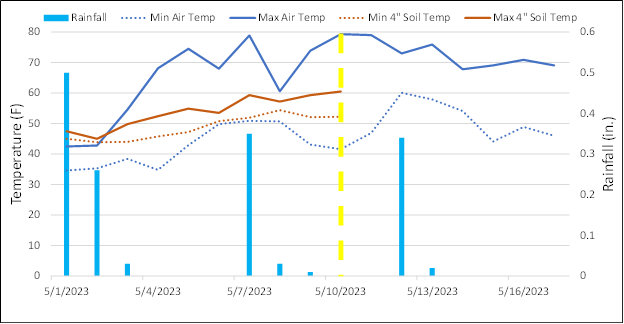
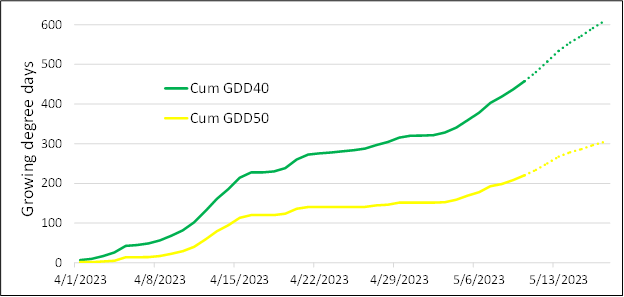
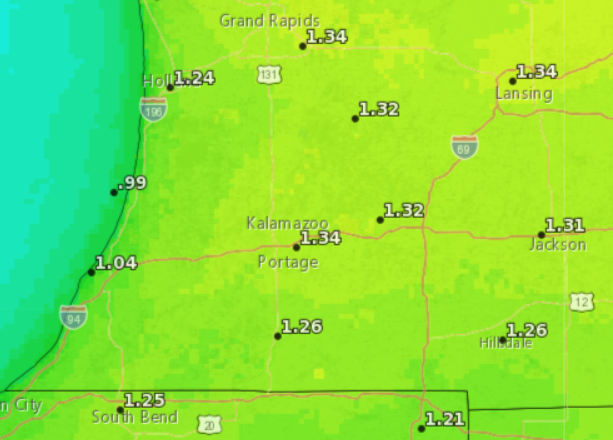
Rainfall this past week was sporadic but near normal, although some areas received 0.5 to 1.0 inch less than normal. The rain forecasted for this weekend has been downgraded, but the next chance of rain is coming on Friday, May 12. Andresen says the high-pressure center over Canada will keep precipitation with this weather system south, and a distinct line can be seen in the forecast model. We’ll just have to see how far south that rain is held as the model currently predicts between 0.25 and 1.25 inches for the coming week—essentially all of that falling Friday into Saturday. The current 6-10 day and 8-14 day forecasts predict below-normal chances of precipitation through the third week of May.

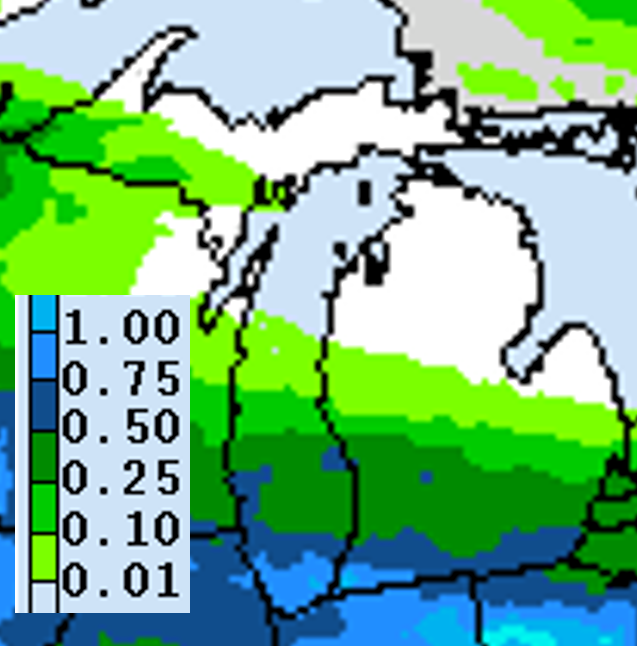

Crops and pests
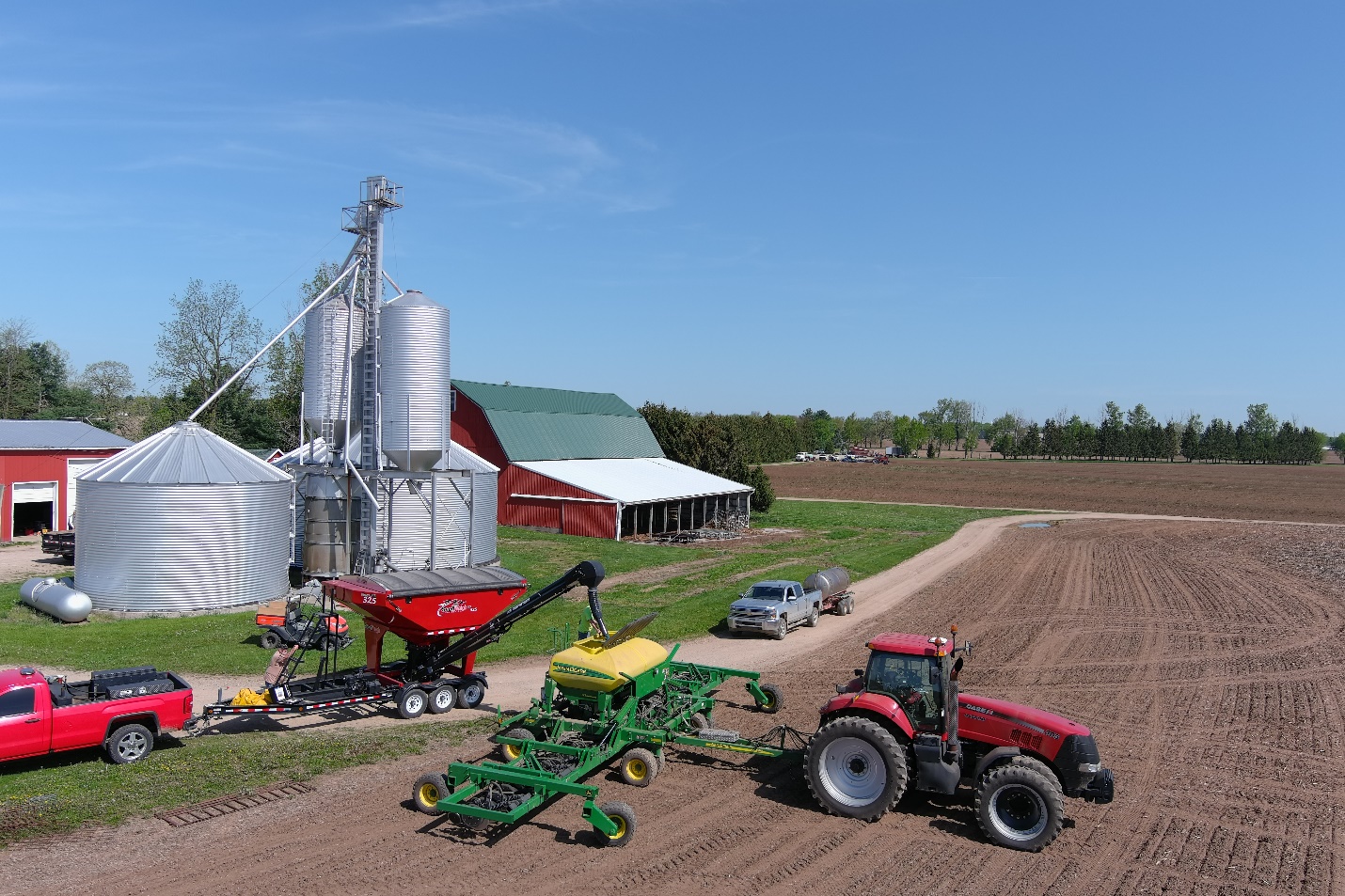
Corn and soybean planting progress showed 6% and 15% planted in Michigan, respectively, as of May 7 according to the latest USDA Crop Report. We slipped a bit behind the five-year average of 18% for corn and 16% for soybean. However, with the warm and mostly dry weather this past week, that number is sure to surge for the upcoming report.
Winter wheat ratings in Michigan held steady according to the current USDA Crop Report with 64% rated as good or excellent and an additional 30% rated as fair. Wheat has reached Feekes 7 (two nodes visible) in all fields visited in southwest Michigan, and one field with an earlier variety had three nodes visible, which could indicate that the flag leaf has begun to emerge (Feekes 8). Check out this MSU Extension article or this video from “Wheat Pete” for how to identify the flag leaf. Observations came in from southeast Michigan of flag leaf emergence in this week’s wheat watchers report.
Herbicide options continue to decrease as Huskie, Harmony and Affinity BroadSpec, among others, need to be applied prior to Feekes 8 (flag leaf becomes visible), according to the MSU Weed Control Guide for Field Crops. Heading has begun in southern Indiana, but the risk of head scab remains low throughout the region.


Irrigation
Wheat and alfalfa are crops that start early in the spring and have their maximum water use during May and June when we typically think of rainfall as being sufficient. Wheat and alfalfa use almost the same amount of water as 6-inch grass (ET reference crop). Irrigators will need to subtract rainfall received toward the end of this week from 1.3 inches (FRET) to calculate the amount of irrigation needed to replace what the crop used. Depending on how much soil moisture you have currently, you may be best advised to make more than just a maintenance application. More information on irrigating wheat can be found in “Considerations for raising irrigated wheat.”
Insects
The trend in low or declining true armyworm (TAW) and black cutworm (BCW) trap counts continued in Indiana this past week (April 26 – May 3) as did counts from southwest Michigan. It’s hard to know to what extent these pests are in our fields without scouting. Assuming that we did get a deposit of black cutworm with storm fronts in early April, they should be developing to the larval stage where stem cutting is possible (around 300 GDD50 since egg hatch) by next week, so be sure to monitor early plantings, particularly if winter annual weeds were prevalent. The fact that true armyworm continues to be found in traps indicates that those moths have made it to Michigan. However, according to MSU field crops entomologist Chris DiFonzo, without a definite biofix and associated development timeline for true armyworm, we have to rely on scouting to see what, if any, crop impacts will be observed.
|
Moth captures from Indiana for the week ending May 3, 2023. Black cutworm trap counts marked with an asterisk were considered “significant” by Purdue staff. |
|||||
|---|---|---|---|---|---|
|
BCW |
Week 1 |
Week 2 |
Week 3 |
Week 4 |
Week 5 |
|
Allen |
0 |
1 |
0 |
-- |
-- |
|
Allen |
1 |
2 |
3 |
3 |
3 |
|
Allen |
61* |
50* |
26* |
43* |
15 |
|
Elkhart |
5 |
30* |
8 |
8 |
4 |
|
Jasper |
65* |
3 |
4 |
0 |
0 |
|
Jasper |
0 |
9 |
10 |
11 |
-- |
|
Kosciusko |
13 |
24* |
24* |
8 |
12 |
|
Lake |
151* |
948 |
52* |
16 |
20* |
|
Lake |
5 |
16 |
19* |
6 |
8 |
|
Lake |
0 |
1 |
9 |
7 |
10 |
|
LaPorte |
26* |
27* |
27* |
6 |
16 |
|
Porter |
16* |
39* |
27* |
17 |
6 |
|
St. Joseph |
0 |
25* |
42* |
-- |
-- |
|
Whitley |
74* |
76* |
58* |
11 |
17* |
|
Whitley |
32* |
15 |
5 |
13 |
6 |
|
TAW |
Week 1 |
Week 2 |
Week 3 |
Week 4 |
Week 5 |
|
Pinney |
60 |
296 |
216 |
54 |
56 |
|
NEPAC |
0 |
259 |
179 |
13 |
39 |
|
Moth captures from traps set in southwest Michigan for the week ending on the given date. |
|||||
|
17-Apr |
24-Apr |
1-May |
8-May |
||
|
Armyworm |
TAW 1 |
69 |
1 |
1 |
1 |
|
TAW 2 |
1 |
11 |
11 |
7 |
|
|
TAW 3 |
2 |
1 |
0 |
5 |
|
|
TAW 4 |
0 |
13 |
1 |
9 |
|
|
Black cutworm |
BCW 1 |
0 |
0 |
0 |
0 |
|
BCW 2 |
0 |
0 |
0 |
1 |
|
|
BCW 3 |
1 |
3 |
1 |
0 |
|
|
BCW 4 |
2 |
0 |
0 |
0 |
|
Soybeans and nitrogen applications was the topic of this week’s MSU Extension Field Crops Virtual Breakfast with soil fertility specialist Kurt Steinke. A “yield gap” exists between higher and lower soybean yields in the Midwest—70 bushels per acre being the approximate boundary—and many farmers wonder if the soybean crop can generate enough nitrogen (N) to provide crop demand. Steinke says that according to a 2018 survey, about half of Michigan soybean acres receive some level of N fertilizer. The question is: Does soybean respond to N applications?
Soybean takes up 5 lb N per bushel, and 3.3 lb N per bushel is removed with the grain. That N comes from biological N fixation by rhizobia, residual soil N, mineralization of N from organic sources, and atmospheric deposition. University research has found that rhizobia housed in nodules on soybean roots provide 44-72% of N that the plant needs. High levels of N in the soil reduce nodulation, so researchers and farmers want to know whether adding additional N fertilizer will actually decrease N fixation by rhizobia. Steinke says he has found that adding starter fertilizer at less than 25 lbs N per acre does not inhibit N fixation while higher rates have inhibited nodulation.
But does the additional N result in increased yields, and is it economically profitable? Steinke often sees a visible difference in soybean plant growth following N fertilizer applications (see photo below), and occasionally he finds a yield advantage. Generally, however, there is no yield response, and the effect of environment in a given growing season is highly variable. Mike Staton, MSU Extension soybean senior educator, added that he also has not found that N applications in soybean are economically beneficial in years of on-farm research trials. Read “Nutrient management recommendations for profitable soybean production” for more details.
So, are there ever times when applying additional N is warranted? If nodulation fails, supplemental N can be profitable. Failures can occur in manured fields, where forage legumes were previously grown, or in fields where soybeans have never been grown, particularly if a seed inoculant was not used. Steinke said 50-80 lb N per acre applied between R1 and R3 could mitigate this scenario. In the MSU Extension article, “Identifying and responding to soybean inoculation failures,” Staton also identified the following causes for nodulation failure: soil pH below 5.5 or above 8.0; residual soil N levels greater than 40 lbs per acre; flooding; improper fungicide and inoculant application to the seed; and poor quality inoculant due to improper storage.
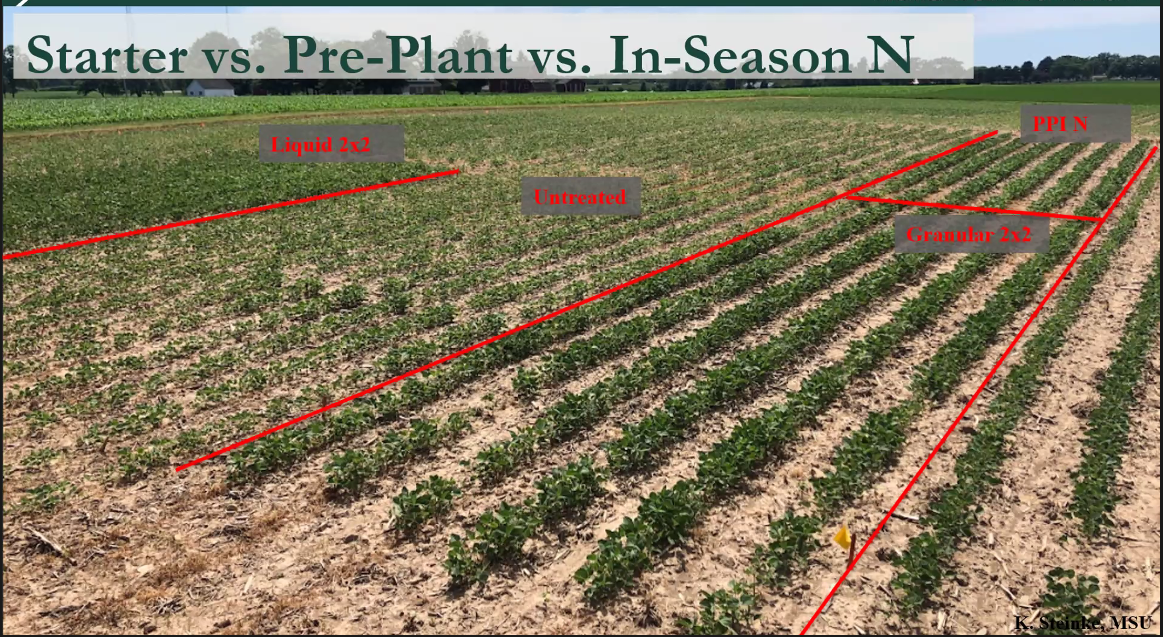
If you were not able to join the session, the recordings will be closed-captioned and available at the Field Crops Virtual Breakfast webpage and the MSU Extension Field Crops Team social media platforms: Facebook, Spotify, YouTube, Apple Podcasts and Twitter.



 Print
Print Email
Email